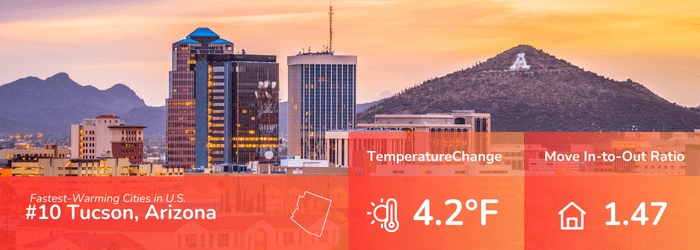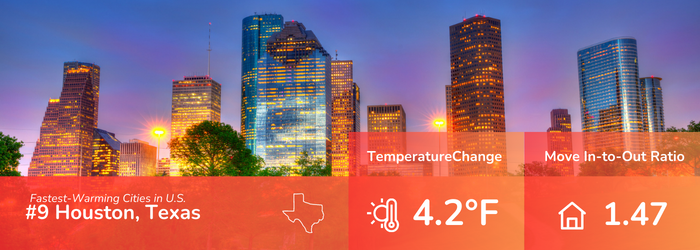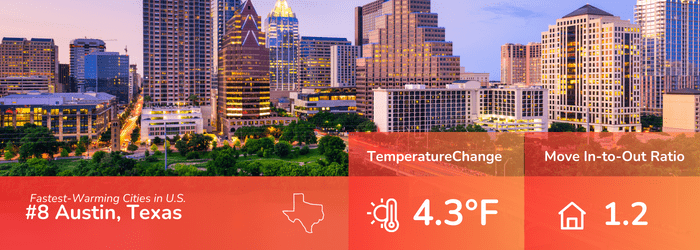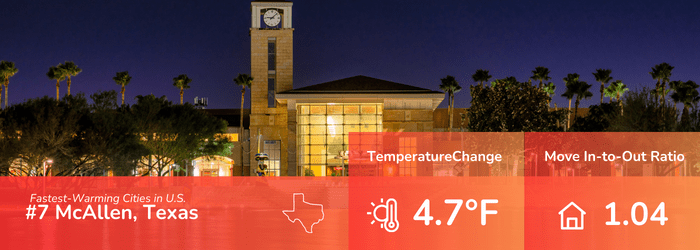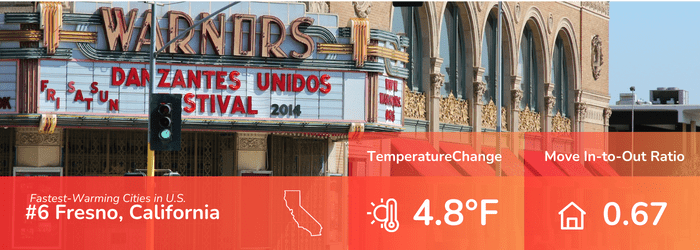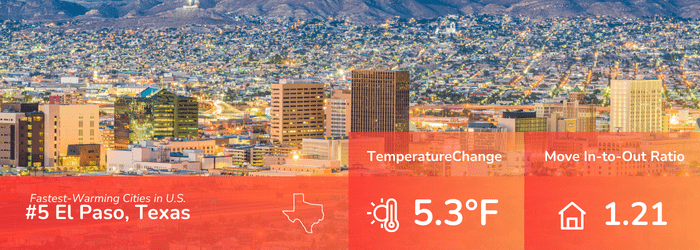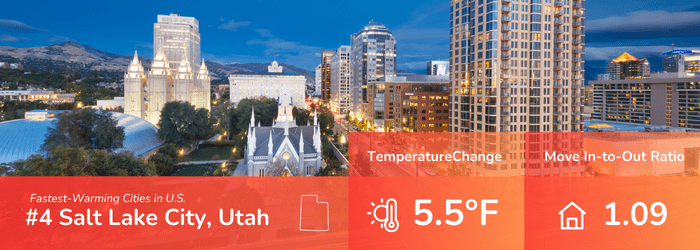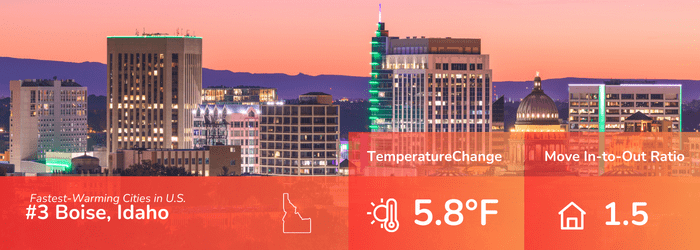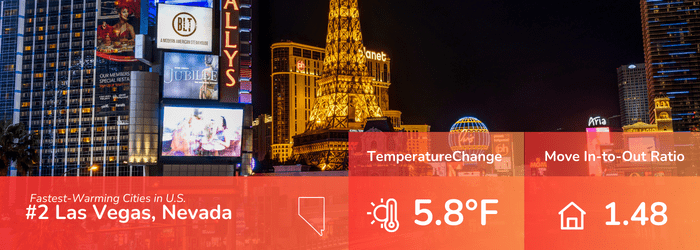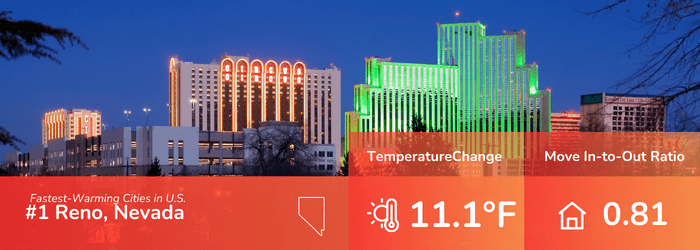Beating the Heat: U.S. Movers Still Heading to the Nation’s Top 10 Fastest-Warming Cities
Summers are getting hotter, and some U.S. cities are heating up more than others. But so far, it’s not affecting where Americans choose to live.
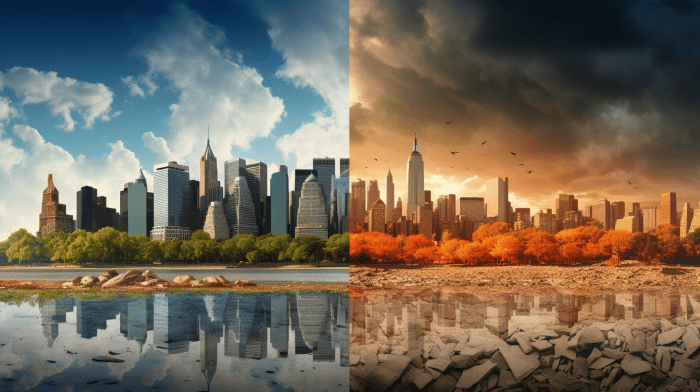
Climate Central data has found that since 1970, summers have warmed in 229 U.S. cities by an average of 2.4°F. “Unusually hot” summer days now happen more often in 231 U.S. cities.
This past summer has been another stark reminder of the increasing effects of climate change. June 2023 was the hottest June on record, with an average global surface temperature of 1.89°F above average.
Climate Central data shows the top 5 warming U.S. cities are:
- Reno, Nevada (11.1°F)
- Las Vegas, Nevada (5.8°F)
- Boise, Idaho (5.8°F)
- Salt Lake City, Utah (5.5°F)
- El Paso, Texas (5.3°F)
Are the fast-rising temperatures in American cities affecting moving trends?
The short answer is no.
moveBuddha compared Census population data and our proprietary 2023 moving trends data with the top 10 American fastest-warming cities between 1970 and 2022, according to Climate Central data.
We discovered that not only are warming temperatures not affecting moving trends, but some of the fastest-warming cities in the U.S. are also attracting strong moving interest and population growth.
Global Warming, No Problem? America’s Fastest-Warming Cities Aren’t Lacking in Moving Interest
Here are the top 10 fastest-warming cities in the U.S. and how they’re doing regarding moving interest and population growth.
#10 Tucson, Arizona - Getting hotter in the AZ Sun Corridor
Change in summer temperature average: 4.2°F
Change in summer days above normal: 39
Average 2022 summer temperature: 88.3°F
2023 Move In-to-Out Ratio: 1.47
Population % Change, 2020-2022: 0.7%
July 2023 Zillow Home Value Index (ZHVI): $322,467
1-Year ZHVI Change: -1.3%
Blistering summer temperatures aren’t preventing people from moving to Tucson or the cities near it. moveBuddha data shows Tucson has a robust 1.47 move-in-to-out ratio in 2023, meaning for every 100 people wanting to move out of the area, 147 are interested in moving in.
Tucson isn’t the most popular destination in Arizona, as Census data shows the area grew by just 0.7% between 2020 and 2022. And many reports indicate most people who move to Tucson opt for towns outside the city, such as Sahuarita.
But this may have more to do with a sluggish Tucson economy that’s too reliant on government jobs - not the blazing heat. It’s hard to escape the heat no matter where you live in Arizona, but the state has added 860,000 new residents in the past decade.
#9 Houston, Texas - The Bayou City is warming up
Change in summer temperature average: 4.2°F
Change in summer days above normal: 53
Average 2022 summer temperature: 86.7°F
2023 Move In-to-Out Ratio: 1.47
Population % Change, 2020-2022: 0.1%
July 2023 Zillow Home Value Index (ZHVI): $261,794
1-Year ZHVI Change: -0.6%
A recent moveBuddha report predicted that Houston would be the #2 most populated city in America by 2100. moveBuddha data also shows Americans are still interested in moving to Houston in 2023, with a ratio of 1.47.
Census data shows population growth in Houston has slowed lately, growing an anemic 0.1% between 2020 and 2022. However, this may only be a temporary lull as the Houston MSA’s population grew by 20.3% between 2010 and 2020, among the strongest rates in all of America.
Extreme heat in Houston hasn’t slowed interest in living in the Bayou City - for now, anyway. Official thermometers at one Houston airport have recorded 190 hours of heat index temperatures at or above 105°F so far this summer.
The risk of hurricanes is a bigger problem for Houston. CoreLogic estimates that by 2050, there will be a 50% increase in homes at risk from storm surges in Harris County. Climate change may lead to rising sea levels, more potent storms, and warmer atmospheric temperatures. This could put Houston's growth at serious risk.
#8 Austin, Texas - Brutal summers aren’t slowing growth
Change in summer temperature average: 4.3°F
Change in summer days above normal: 47
Average 2022 summer temperature: 88.8°F
2023 Move In-to-Out Ratio: 1.2
Population % Change, 2020-2022: 1.3%
July 2023 Zillow Home Value Index (ZHVI): $557,292
1-Year ZHVI Change: -9.8%
Given current growth trends, Austin could be America’s #3 most populated city by 2100, according to moveBuddha. Few U.S. cities are growing as rapidly as Austin, and that’s been the case for a long time. Austin’s population growth rate of 32.9% between 2010 and 2020 was second only to Myrtle Beach, South Carolina, during that period.
The extreme heat isn’t making Americans avoid moving to the “Live Music Capital of The World.” This summer is on track to be the most extreme heat-wise for Texas, and Austin has seen plenty of triple-digit temperature days.
2022 wasn’t much better. Temperatures in the greater Austin area during June, July, and August 2022 were as much as 5 degrees above average, and rainfall was below normal, leaving waterways sucked dry.
#7 McAllen, Texas - Deep South Texas growth & extreme heat
Change in summer temperature average: 4.7°F
Change in summer days above normal: 48
Average 2022 summer temperature: 87.2°F
2023 Move In-to-Out Ratio: 1.04
Population % Change, 2020-2022: 1.7%
July 2023 Zillow Home Value Index (ZHVI): $214,028
1-Year ZHVI Change: +5.8%
McAllen is another Texas city that finds itself on this list. Like many Texas cities, it is growing fast and is expected to continue doing so. The McAllen metro area is projected to grow from a population of 895,000 in 2022 to about 1.58 million in 2060, according to Woods & Poole Economics.
Deep in South Texas on the border of Mexico, McAllen is also known to have scorching temperatures that keep getting higher. The city reached its highest temperature of 2023 on June 21 at 108°, maintaining that level for most of the week.
McAllen is no stranger to extreme heat - yet people continue to move there. Temperatures in McAllen and nearby cities were hotter than in Death Valley in the summer of 2019. The heat index in Brownsville - not far from McAllen - hit an unofficial figure of 128 degrees one day that summer. It was so hot that the National Weather Service maps didn’t even have a color on their charts to represent it, according to one report.
#6 Fresno, California - A hot CA outlier drawing move-in interest
Change in summer temperature average: 4.8°F
Change in summer days above normal: 32
Average 2022 summer temperature: 84.5°F
2023 Move In-to-Out Ratio: 0.67
Population % Change, 2020-2022: 0.6%
July 2023 Zillow Home Value Index (ZHVI): $365,712
1-Year ZHVI Change: -1.4%
Between 2012 and 2021 was the hottest decade on record for Fresno, California, according to National Weather Service historical records. The city’s location in a valley is one reason it’s so hot. High-pressure areas get so strong that they push the jet stream well off to the north. This makes it hard for cooling systems to get into the valley, and when that does happen, they’re weak.
Fresno’s average summer temperature increased by 4.8°F between 1970 and 2022, so there’s no denying it's getting hotter there. The hot summers don’t seem to be pushing residents away, though. moveBuddha data shows tepid interest in moving to Fresno, and Census data shows a modest population growth rate of 0.6% between 2020 and 2022.
But other reports indicate Fresno is a rare California city seeing move-in interest. Some people moving to the Golden State choose Fresno over more-expensive coastal areas like San Francisco. The trend intensified during the pandemic and pre-dates the COVID health crisis. In a state where many areas struggle with extreme heat and wildfires, Fresno has become an outlier drawing move-in interest.
#5 El Paso, Texas - High heat, slow growth
Change in summer temperature average: 5.3°F
Change in summer days above normal: 44
Average 2022 summer temperature: 84.5°F
2023 Move In-to-Out Ratio: 1.21
Population % Change, 2020-2022: -0.2%
July 2023 Zillow Home Value Index (ZHVI): $211,670
1-Year ZHVI Change: +7.0%
El Paso is a border town situated in the far Northwest corner of Texas on the border of New Mexico and Mexico. And like the four other Texas cities on this list, the city has gone through a brutally hot summer in 2023.
The Sun City experienced 23 straight days of triple-digit temperatures through July for the first time since 1994. The scorching hot weather has increased demand for the city’s electric grid and higher electricity bills.
El Paso’s average summer temperatures have increased by more than five degrees since 1970, but it’s unclear if it’s affecting moving trends. moveBuddha data shows a healthy 1.21 moving ratio for the city in 2023, but recent Census data shows El Paso lost 0.2% of its population between 2020-2022.
El Paso has had flat population growth for the past decade, a big difference from other Texas cities. Texas’ population growth of 1.5% between 2021 and 2022 was nearly 20 times faster than El Paso County. The heat in the Sun City may not be a factor for the lack of net in-migration. A more likely factor is that in El Paso, average private sector wages are less than two-thirds of state and national averages.
#4 Salt Lake City, Utah - Fast growth despite heat waves
Change in summer temperature average: 5.5°F
Change in summer days above normal: 39
Average 2022 summer temperature: 79.3°F
2023 Move In-to-Out Ratio: 1.09
Population % Change, 2020-2022: 2.5%
July 2023 Zillow Home Value Index (ZHVI): $539,997
1-Year ZHVI Change: -3.5%
Utah was the nation’s fastest-growing state between 2010 and 2020, according to Census data, and it’s mainly because more people moved into the state than out of it. Utah gained about 121,000 new residents annually between 2015 and 2019, and most settled in Davis, Salt Lake, Utah, or Washington Counties.
Salt Lake City is a popular destination for Americans moving to Utah. The city has a positive moving ratio of 1.09 in 2023, which is surprisingly low for the city’s popularity. Census data shows Salt Lake City’s population grew by a robust rate of 2.5% between 2020-2022.
But Salt Lake City is also the #4 fastest-warming city, with its average summer temperature rising 5.5 degrees since 1970. Utah’s capital city experienced its hottest July on record in 2023 for the second consecutive year.
The average temperature in July was 87.3 degrees, 6.2 degrees above normal. At one point this summer, Salt Lake City saw 21 straight days of 100 degrees or more. The summer heat waves don’t appear to be slowing down migration to Salt Lake City, though.
#3 Boise, Idaho - A popular fast-warming city
Change in summer temperature average: 5.8°F
Change in summer days above normal: 33
Average 2022 summer temperature: 76.7°F
2023 Move In-to-Out Ratio: 1.5
Population % Change, 2020-2022: 0.4%
July 2023 Zillow Home Value Index (ZHVI): $472,757
1-Year ZHVI Change: -6.7%
It may come as a surprise that Boise, Idaho, is #3 on this list, but the city has been heating up quickly. Ten of the 12 hottest summers in Boise's history have come since the start of the 21st century, and the city’s average summer temperature has spiked 5.8 degrees since 1970.
The summer heat hasn’t slowed down Americans moving to Idaho, though. Idaho is one of the nation’s fastest-growing states, seeing its population increase by 2.9% between 2020 and 2021. moveBuddha data shows Boise is popular in 2023, with a move-in-to-out ratio of 1.5. It may be getting hotter in Boise, but that isn’t stopping its popularity as a destination city.
#2 Las Vegas, Nevada - Sweating it out in Sin City
Change in summer temperature average: 5.8°F
Change in summer days above normal: 41
Average 2022 summer temperature: 91.2°F
2023 Move In-to-Out Ratio: 1.48
Population % Change, 2020-2022: 1.8%
July 2023 Zillow Home Value Index (ZHVI): $396,062
1-Year ZHVI Change: -7.3%
Despite the heat, Las Vegas is a top moving destination in the U.S. Recent moveBuddha reports have shown that Nevada and Las Vegas are big draws for residents leaving California, especially San Francisco. Sin City’s population swelled by 1.8% between 2020 and 2022, and moveBuddha data shows the city has a robust 1.48 moving interest ratio so far this year.
The brutally hot temperatures haven’t cooled down the influx of new residents. Las Vegas’ average 2022 summer temperature of 91.2 degrees makes it the hottest metropolitan area on this list, and it keeps getting hotter. The average summer temps spiked 5.8 degrees between 1970 and 2022.
July 2023 was Las Vegas’ hottest month ever recorded, with a blistering stretch of days that reached 110 degrees or hotter. The average temperature in Las Vegas that month was 97.3 degrees. The extreme heat has had consequences. The Southern Nevada Health District reports seven heat-related deaths since April and 152 heat-related deaths last year.
#1 Reno, Nevada - Another fast-warming & growing Nevada city
Change in summer temperature average: 11.1°F
Change in summer days above normal: 66
Average 2022 summer temperature: 76.1°F
2023 Move In-to-Out Ratio: 0.81
Population % Change, 2020-2022: 3.5%
July 2023 Zillow Home Value Index (ZHVI): $524,127
1-Year ZHVI Change: -5.6%
Reno is about a seven-hour drive away from Las Vegas to the northwest on the California border. It’s not nearly as hot in Reno as in Vegas, but it’s getting hotter each year.
A couple of things could skew Reno’s spot on this list, though. It was a relatively cooler period in the ‘70s when Climate Central’s study began, and the location of the city’s official recording station also changed.
But it doesn’t change the fact that Reno’s average summer temperature has increased by more than 11 degrees since 1970 - by far the most on this list and more than five degrees higher than #2 Vegas. As Reno has grown, the urban heat island effect has contributed to this. More buildings, asphalt, concrete surfaces, and less vegetation absorb heat and warm things up.
Despite the increasing temps, Reno is growing fast. According to Census data, the Reno metro area population grew by 15.3% between 2010 and 2020, only slightly less than the Las Vegas MSA. moveBuddha data shows a tepid 0.81 moving ratio for Reno this year, but Census data also indicates a population change of 3.5% between 2020 and 2022.
Will Hotter Temperatures in Fast-Growing U.S. Cities Ever Lead to a Cool-Down in Moving Trends?
Most Americans aren’t factoring in climate change risks like extreme heat when choosing where to live today.
This is evident in multiple studies, including moveBuddha’s examination of the top 10 fastest-warming American cities and their population growth. A study by online real estate brokerage firm Redfin on domestic migration also found that Americans are still moving to zip codes with a high risk of wildfire, drought, and flood.
There are a few outliers where population growth is flat or even negative - such as El Paso, Texas - but for the most part, America’s fastest-warming cities are attracting strong moving interest.
- moveBuddha found that the top 10 fastest-warming U.S. cities have, on average, a positive 1.19 move-in-to-out ratio in 2023. In addition, Census data shows these cities’ populations grew by an average of 1.24% between 2020 and 2022.
The average American, perhaps working a white-collar job and avoiding the heat by blasting their air conditioning, may only see the blazing hot summers in recent years as an inconvenience. Heat-related illnesses and deaths are rising in these fast-warming cities, as are electric bills, but it hasn’t reached a tipping point yet where it is leading to so-called “climate migration.”
As heat records keep being broken each year, though, this could change.
The top 10 fastest-warming cities in America are all located in the West or Southwest, where climate change contributes to water scarcity and increasing wildfires. Hotter temperatures also strain electric grids and could lead to blackouts - taking away coveted air conditioning.
For now, Americans keep moving toward danger and extreme heat. But if climate scientists’ ominous projections come true, there may soon be a time when the thermostats get so high that Americans can’t beat the heat anymore and must find more moderate options. In a world and nation where nearly every city is warming fast, the question is where those climate-safe havens will be.
Sources & Methodology
The move-in-to-out ratio data was collected from January 1, 2023, through June 8, 2023, and includes searches nationwide by individuals who were either planning to move or hire a moving company throughout 2023.
More information about our move data and in-to-out ratio equation can be found in our annual Migration Report.
The core climate data for this report was taken from the Climate Central 2023 Summer Package. This includes the average change in summer temperatures and average summer days above normal temperatures, which were measured between 1970 and 2022.
The average temperature data for the summer of 2022 was sourced from the NOAA’s Climate at Glance City Time Series.
The city population percent change data was taken from the U.S. Census Bureau’s Quick Facts page and was measured between April 1, 2020, and July 1, 2022, for all of the ten cities in the report.
The Zillow Home Value Index for all ten cities in this report is from Zillow data captured through July 31, 2023, and measures the ZHVI for all home types.
Media Contact
Members of the media with questions about this report or who would like to cover it can contact:
Nick Pipitone
Communications Manager, moveBuddha
Email: [email protected]
Not what you were looking for?
Check out other categories that can help you find the information you need!
